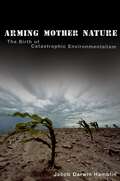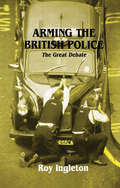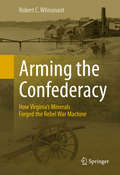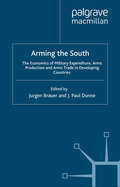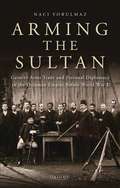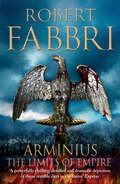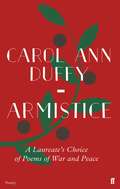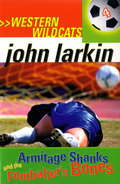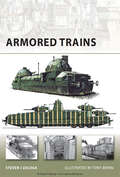- Table View
- List View
Arming Mother Nature: The Birth of Catastrophic Environmentalism
by Jacob Darwin HamblinWhen most Americans think of environmentalism, they think of the political left, of vegans dressed in organic-hemp fabric, lofting protest signs. In reality, writes Jacob Darwin Hamblin, the movement--and its dire predictions--owe more to the Pentagon than the counterculture. In Arming Mother Nature, Hamblin argues that military planning for World War III essentially created "catastrophic environmentalism": the idea that human activity might cause global natural disasters. This awareness, Hamblin shows, emerged out of dark ambitions, as governments poured funds into environmental science after World War II, searching for ways to harness natural processes--to kill millions of people. Proposals included the use of nuclear weapons to create artificial tsunamis or melt the ice caps to drown coastal cities; setting fire to vast expanses of vegetation; and changing local climates. Oxford botanists advised British generals on how to destroy enemy crops during the war in Malaya; American scientists attempted to alter the weather in Vietnam. This work raised questions that went beyond the goal of weaponizing nature. By the 1980s, the C.I.A. was studying the likely effects of global warming on Soviet harvests. "Perhaps one of the surprises of this book is not how little was known about environmental change, but rather how much," Hamblin writes. Driven initially by strategic imperatives, Cold War scientists learned to think globally and to grasp humanity's power to alter the environment. "We know how we can modify the ionosphere," nuclear physicist Edward Teller proudly stated. "We have already done it." Teller never repented. But many of the same individuals and institutions that helped the Pentagon later warned of global warming and other potential disasters. Brilliantly argued and deeply researched, Arming Mother Nature changes our understanding of the history of the Cold War and the birth of modern environmental science.
The Arming of Europe and the Making of the First World War (Princeton Studies In International History And Politics)
by David G. HerrmannDavid Herrmann's work is the most complete study to date of how land-based military power influenced international affairs during the series of diplomatic crises that led up to the First World War. Instead of emphasizing the naval arms race, which has been extensively studied before, Herrmann draws on documentary research in military and state archives in Germany, France, Austria, England, and Italy to show the previously unexplored effects of changes in the strength of the European armies during this period. Herrmann's work provides not only a contribution to debates about the causes of the war but also an account of how the European armies adopted the new weaponry of the twentieth century in the decade before 1914, including quick-firing artillery, machine guns, motor transport, and aircraft. In a narrative account that runs from the beginning of a series of international crises in 1904 until the outbreak of the war, Herrmann points to changes in the balance of military power to explain why the war began in 1914, instead of at some other time. Russia was incapable of waging a European war in the aftermath of its defeat at the hands of Japan in 1904-5, but in 1912, when Russia appeared to be regaining its capacity to fight, an unprecedented land-armaments race began. Consequently, when the July crisis of 1914 developed, the atmosphere of military competition made war a far more likely outcome than it would have been a decade earlier.
Arming Slaves: From Classical Times to the Modern Age (The David Brion Davis Series)
by Christopher Leslie Brown Philip D. MorganArming slaves as soldiers is a counterintuitive idea. Yet throughout history, in many varied societies, slaveholders have entrusted slaves with the use of deadly force. This book is the first to survey the practice broadly across space and time, encompassing the cultures of classical Greece, the early Islamic kingdoms of the Near East, West and East Africa, the British and French Caribbean, the United States, and Latin America.To facilitate cross-cultural comparisons, each chapter addresses four crucial issues: the social and cultural facts regarding the arming of slaves, the experience of slave soldiers, the ideological origins and consequences of equipping enslaved peoples for battle, and the impact of the practice on the status of slaves and slavery itself. What emerges from the book is a new historical understanding: the arming of slaves is neither uncommon nor paradoxical but is instead both predictable and explicable.
Arming the British Police: The Great Debate
by Roy IngletonAs the fear of violent crime escalates, there are calls for the police to carry guns. This examination of the history of violent crime and violence against the representatives of law and order looks at the extent to which the "unarmed" British police have had recourse to firearms in the past.
Arming the British Police: The Great Debate
by Roy IngletonAs the fear of violent crime escalates, there are calls for the police to carry guns. This examination of the history of violent crime and violence against the representatives of law and order looks at the extent to which the "unarmed" British police have had recourse to firearms in the past.
Arming the Confederacy: How Virginia’s Minerals Forged the Rebel War Machine
by Robert C. WhisonantThis is a fresh look at the American Civil War from the standpoint of the natural resources necessary to keep the armies in the field. This story of the links between minerals, topography, and the war in western Virginia now comes to light in a way that enhances our understanding of America’s greatest trial. Five mineral products – niter, lead, salt, iron, and coal – were absolutely essential to wage war in the 1860s. For the armies of the South, those resources were concentrated in the remote Appalachian highlands of southwestern Virginia. From the beginning of the war, the Union knew that the key to victory was the destruction or occupation of the mines, furnaces, and forges located there, as well as the railroad that moved the resources to where they were desperately needed. To achieve this, Federal forces repeatedly advanced into the treacherous mountainous terrain to fight some of the most savage battles of the War.
Arming the Free World: The Origins of the United States Military Assistance Program, 1945-1950
by Chester J. PachIn this important study, Chester Pach traces the emergence of military assistance as a major instrument of contemporary American foreign policy. During the early Cold War, arms aid grew from a few country and regional programs into a worldwide effort with an annual cost of more than $1 billion. Pach analyzes the Truman administration's increasing reliance on arms aid--for Latin America, Greece and Turkey, China, and Western Europe--to contain Communist expansion during the late 1940s. He shows that a crucial event was the passage of the Mutual Defense Assistance Act of 1949, the progenitor of a long series of global, Cold War arms measures.Pach demonstrates that the main impetus for the startling growth of military assistance was a belief that it would provide critical political and psychological reassurance to friendly nations. Although this aid was ostensibly provided for military purposes, the overriding goals were insuring goodwill, raising foreign morale, stiffening the will to resist communism, and proving American resolve and reliability.Policymakers, Pach contends, confused means with ends by stressing the symbolic importance of furnishing aid. They sought additional appropriations with the threat that any diminution or cessation of aid suggested a weakening of American commitment. Pach reveals that civilian, not military, officials were the principal advocates of the expansion of military aid, and he shows how the policies established during the Truman administration continued to exert a profound influence throughout the Cold War.Some officials questioned the self-perpetuating qualities of military aid programs, but Pach concludes that their warnings went unheeded. Although fiscal restraints in the Truman administration temporarily stemmed the growth of aid, the Korean War exploded budgetary limitations. MIlitary assistance spending expanded rapidly in size and scope, gaining a momentum that succeeding administrations could not resist.Originally published in 1991.A UNC Press Enduring Edition -- UNC Press Enduring Editions use the latest in digital technology to make available again books from our distinguished backlist that were previously out of print. These editions are published unaltered from the original, and are presented in affordable paperback formats, bringing readers both historical and cultural value.
Arming the Periphery: The Arms Trade in the Indian Ocean during the Age of Global Empire
by E. ChewA major historical study of the global arms trade, revolving around the transfer of small arms from metropolitan Europe to the turbulent frontiers of Indian Ocean societies during the 'long' nineteenth century (c.1780-1914).
Arming the Royal Navy, 1793–1815: The Office of Ordnance and the State (Warfare, Society and Culture)
by Gareth ColeThe Office of Ordnance has been ill-served by previous accounts of its role in arming the Royal Navy during the French Revolution and Napoleonic Wars. Cole offers an in-depth examination of its organizational structure and demonstrates how the department responded to the pressures of war over an extended period of time.
Arming the Royal Navy, 1793–1815: The Office of Ordnance and the State (Warfare, Society and Culture #4)
by Gareth ColeThe Office of Ordnance has been ill-served by previous accounts of its role in arming the Royal Navy during the French Revolution and Napoleonic Wars. Cole offers an in-depth examination of its organizational structure and demonstrates how the department responded to the pressures of war over an extended period of time.
Arming the South: The Economics of Military Expenditure, Arms Production and Arms Trade in Developing Countries
by J. Brauer P. DunneAfter marked reductions in military spending in the 1990s military budgets around the world are on the increase. In this book, renowned authorities re-examine the economics of military expenditure, arms production and arms trade in developing nations. It includes analysis of military spending in Africa, Asia and Latin America and new forms of civil conflict as well as nine case studies (Saudi Arabia, South Africa, Mozambique, Angola, Subsaharan Africa, Greece, Turkey, Guatemala and Chile). The book will serve as a valuable contribution to the fields of both development economics and security studies.
Arming the Sultan: German Arms Trade and Personal Diplomacy in the Ottoman Empire Before World War I
by Naci YorulmazAt the beginning of the nineteenth century, the Ottoman arms industry was self-sufficient. But from the 1880s to World War I, German arms companies held a monopoly position in the Ottoman arms market. How did Germany manage to conquer what had until then been an extremely competitive market, where British, French and American firms had been dominant for years? While acknowledging the importance of economic and political factors, Arming the Sultan suggests that the main determinants of the German success cannot be ascribed only to the market theory of supply and demand, but lie instead in a range of manipulative instruments built on foundations that were formed through close personal relations. Yorulmaz's innovative book suggests that the value of these relationships has been overlooked, and ensured German success over British, French and American competition. Based on extensive multinational archival research in Germany, Turkey, Britain and the United States, Arming the Sultan explores the decisive impact of arms exports on the formation and stimulation of Germany's expansionist foreign economic policy towards the Ottoman Empire.Making an important contribution to the field of the historiography of the political economy of the international arms trade in the case of Germany's arms sales in the Ottoman Empire, Arming the Sultan reveals that arms exports proved to be an indispensable and integral part of Germany's foreign economic policy during the period under review.
Arming the Sultan: German Arms Trade and Personal Diplomacy in the Ottoman Empire Before World War I (Library of Ottoman Studies)
by Naci YorulmazAt the beginning of the nineteenth century, the Ottoman armaments trade was entirely self-sufficient. But by the end of the century, it was almost entirely under German control. How did Germany under Chancellor Bismarck manage to conquer what had until then been an extremely competitive military market? Focusing on the reign of Sultan Abdülhamid between 1876 and 1909, Naci Yorulmaz's book explores the determining factors that influenced the development of the Ottoman armaments market. While acknowledging the importance of political and economic factors, Arming the Sultan concentrates on the personal relationships which shaped the development of the arms trade, including the bonds between arms-makers and the government, between German politicians and Ottoman grandees, and even the private relationships between Kaiser Wilhelm I, Otto von Bismarck and the Sultan. Yorulmaz's innovative book suggests that the value of these relationships has been overlooked, and ensured German success over British, French and American competition.
Arming the Western Front: War, Business and the State in Britain 1900–1920 (Routledge Studies in First World War History)
by Roger Lloyd-Jones M.J. LewisThe First World War was above all a war of logistics. Whilst the conflict will forever be remembered for the mud and slaughter of the Western Front, it was a war won on the factory floor as much as the battlefield. Examining the war from an industrial perspective, Arming the Western Front examines how the British between 1900 and 1920 set about mobilising economic and human resources to meet the challenge of 'industrial war'. Beginning with an assessment of the run up to war, the book examines Edwardian business-state relations in terms of armament supply. It then outlines events during the first year of the war, taking a critical view of competing constructs of the war and considering how these influenced decision makers in both the private and public domains. This sets the framework for an examination of the response of business firms to the demand for 'shells more shells', and their varying ability to innovate and manage changing methods of production and organisation. The outcome, a central theme of the book, was a complex and evolving trade-off between the quantity and quality of munitions supply, an issue that became particularly acute during the Battle of the Somme in 1916. This deepened the economic and political tensions between the military, the Ministry of Munitions, and private engineering contractors as the pressure to increase output accelerated markedly in the search for victory on the western front. The Great War created a dual army, one in the field, the other at home producing munitions, and the final section of the book examines the tensions between the two as the country strove for final victory and faced the challenges of the transition to the peace time economy.
Arming the Western Front: War, Business and the State in Britain 1900–1920 (Routledge Studies in First World War History)
by Roger Lloyd-Jones M.J. LewisThe First World War was above all a war of logistics. Whilst the conflict will forever be remembered for the mud and slaughter of the Western Front, it was a war won on the factory floor as much as the battlefield. Examining the war from an industrial perspective, Arming the Western Front examines how the British between 1900 and 1920 set about mobilising economic and human resources to meet the challenge of 'industrial war'. Beginning with an assessment of the run up to war, the book examines Edwardian business-state relations in terms of armament supply. It then outlines events during the first year of the war, taking a critical view of competing constructs of the war and considering how these influenced decision makers in both the private and public domains. This sets the framework for an examination of the response of business firms to the demand for 'shells more shells', and their varying ability to innovate and manage changing methods of production and organisation. The outcome, a central theme of the book, was a complex and evolving trade-off between the quantity and quality of munitions supply, an issue that became particularly acute during the Battle of the Somme in 1916. This deepened the economic and political tensions between the military, the Ministry of Munitions, and private engineering contractors as the pressure to increase output accelerated markedly in the search for victory on the western front. The Great War created a dual army, one in the field, the other at home producing munitions, and the final section of the book examines the tensions between the two as the country strove for final victory and faced the challenges of the transition to the peace time economy.
Arminius: The Limits of Empire
by Robert FabbriOne man's greatest victory.Rome's greatest defeat.A.D. 9: In the depths of the Teutoburg Wald, in a landscape riven by ravines, darkened by ancient oak and bisected by fast-flowing streams, Arminius of the Cherusci led a confederation of six Germanic tribes in the annihilation of three Roman legions. Deep in the forest almost twenty thousand men were massacred without mercy; fewer than two hundred of them ever made it back across the Rhine. To Rome's shame, three sacred Eagles were lost that day.But Arminius wasn't brought up in Germania Magna - he had been raised as a Roman. This is the story of how Arminius came to turn his back on the people who raised him and went on to commit a betrayal so great and so deep, it echoed through the ages.______________________________________________Don't miss Robert Fabbri's epic new series Alexander's Legacy
Arminius the Liberator: Myth and Ideology
by Martin M. WinklerArminius the Liberator deals with the complex modern reception of Arminius the Cheruscan, commonly called Hermann. Arminius inflicted one of their most devastating defeats on the Romans in the year 9 A.D. by annihilating three legions under the command of Quintilius Varus in the Battle of the Teutoburg Forest, as it is generally if inaccurately called. This book traces the origin of the Arminius myth in antiquity and its political, artistic, and popular developments since the nineteenth century. The book's central themes are the nationalist use and abuse of history and historical myth in Germany, especially during the Weimar Republic and National Socialism, the reactions to a discredited ideology involving Arminius in post-war Europe, and revivals of his myth in the United States. Special emphasis is on the representation of Arminius in visual media since the 1960s: from painting and theater to cinema, television, and computer animation.
Armistice: A Laureate's Choice of Poems of War and Peace (Faber Poetry Ser.)
by Carol Ann DuffyThe Armistice of 1918 brought ceasefire to the war on the Western Front, but 'the Great War' would not as hoped be 'the war to end all wars'. In this affecting selection, the Poet Laureate, Carol Ann Duffy, guides us deep into the act and root of 'armistice': its stoppage or 'stand' of arms, its search for truce and ceasefire. In 100 poems, our most cherished poets of the Great War speak alongside those from other conflicts and cultures, so that we hear some of the lesser-heard voices of war, including wives, families, those left behind. These poems of war and peace memorialise the horror and the tragedy of conflict. At the same time, in armistice, they become a record of renewal and a testimony to hope.
Armistice
by Nick Stafford Quercus11 a.m., 11th November 1918. Just when Philomena thinks Dan's going to make it home, her fiancé's slain on a battlefield in France.Four months later, grieving Philomena travels to London to meet three soldiers who fought with Dan. Soon she discovers a terrible possibility: Dan's death wasn't at the hands of the enemy. But there is no proof, no witness, only an accusation by one man and the threat of ruin by another should he ever repeat it.Alone in an alien city traumatised by the aftershocks of the war, whom should Philomena believe, who can she trust, in her attempt to discover if Dan was murdered? And this isn't her only challenge. Whilst inching ever closer to the truth Philomena finds herself falling for one of the men...
Armitage Shanks and the Footballer's Bones: Western Wildcats 4 (Western Wildcats #4)
by John LarkinThe Wildcats are in trouble again! Down on the ground, there’s got to be some way of raising funds, and their coach comes up with health food bars. Only trouble is they’re inedible, and whoever sells the most gets an all-expenses-paid trip to Canberra. Up in the air, though, Splinters and Nuke are on their way to London to retrieve their best player, Gazza, who’s been deported back to England with her mum, and the two boys get up to the sort of in-flight antics that have made travelling footballers notorious. Grappling as always with the problem of how to make up the numbers, someone remembers a genius footballer called Armitage Shanks who registered for the Under 6s, but never turned up for training or played a single game. Then the obvious question: how do you know he was a genius? And (to Splinters) the equally obvious answer: he had great boots! But when Armitage Shanks turns up, it’s a bigger surprise than the Wildcats have bargained for. A crazy adventure with an unexpectedly moving conclusion, this is one of John Larkin’s funniest books in the series - but it also offers a little insight into success and fame.
ARMA Model Identification (Springer Series in Statistics)
by ByoungSeon ChoiDuring the last two decades, considerable progress has been made in statistical time series analysis. The aim of this book is to present a survey of one of the most active areas in this field: the identification of autoregressive moving-average models, i.e., determining their orders. Readers are assumed to have already taken one course on time series analysis as might be offered in a graduate course, but otherwise this account is self-contained. The main topics covered include: Box-Jenkins' method, inverse autocorrelation functions, penalty function identification such as AIC, BIC techniques and Hannan and Quinn's method, instrumental regression, and a range of pattern identification methods. Rather than cover all the methods in detail, the emphasis is on exploring the fundamental ideas underlying them. Extensive references are given to the research literature and as a result, all those engaged in research in this subject will find this an invaluable aid to their work.
Armored (Armored)
by Mark GreaneyOne last job, out of the fire, and into hell...From the #1 New York Times bestselling author of The Gray Man series comes a very different kind of hero.Joshua Duffy is a Close Protection Agent - a professional bodyguard, and he's one of the world's elite operatives. That is he was until his last mission in Lebanon. Against all odds, Josh got his primary out alive, but the cost was high. Josh lost his lower left leg. There's not much call for an elite bodyguard with such an injury. So, Josh has to support his family working as a mall cop in Jersey. For a man like Josh this is purgatory on earth, but even in Paramus miracles occur. A lucky run in with an old comrade promises to get Josh back in the field for one last job. The UN is sending a peace mission into the Sierra Madre Mountains in Mexico, an area so dangerous it's known as Espinazo del Diablo (The Devil's Spine). Only a fool would think they could broker peace between the homicidal drug cartels in the region and only a madman would sign on to keep those fools alive.Soon to be a major film by Michael Bay, Armored is a gasp-a-minute rollercoaster of a thriller.
Armored Trains (New Vanguard)
by Steven J. Zaloga Tony BryanFirst seen during the American Civil War and later appearing in the Franco-Prussian War and the Anglo-Boer Wars, the armored train came to prominence on the Eastern Front during World War I. It was also deployed during the Russian Civil War and the technology traveled east into the Chinese Civil War, and the subsequent war with Japan. It saw service on the Russian Front in World War II, but was increasingly sidelined because of its vulnerability to air attack. Steven J Zaloga examines the origins and development of the armored train, focusing equally on the technical detail and on the fascinating story of how armored trains were actually used in combat. This title will appeal to armor, military history and railroad enthusiasts alike.
Armored Trains (New Vanguard #140)
by Steven J. Zaloga Tony BryanFirst seen during the American Civil War and later appearing in the Franco-Prussian War and the Anglo-Boer Wars, the armored train came to prominence on the Eastern Front during World War I. It was also deployed during the Russian Civil War and the technology traveled east into the Chinese Civil War, and the subsequent war with Japan. It saw service on the Russian Front in World War II, but was increasingly sidelined because of its vulnerability to air attack. Steven J Zaloga examines the origins and development of the armored train, focusing equally on the technical detail and on the fascinating story of how armored trains were actually used in combat. This title will appeal to armor, military history and railroad enthusiasts alike.
Armored Units of the Russian Civil War: Red Army (New Vanguard)
by Peter Sarson David BullockBy 1920 the Red Army of Russia fielded an overwhelming array of armored cars, armored trains and tank detachments. These armored units played an important part in consolidating the newly won Bolshevik empire in the early 1920s; as a consequence of the fact that railways were the strategic arteries that essentially controlled Russia, armored trains have never played such a significant role in military history as they did in the Russian Civil War. This title details the management, construction, repair, personnel, training and combat of the Red Army's armored units on all fronts, including such famous vehicles as Trotsky's armored train.
